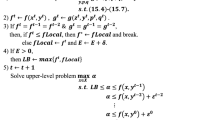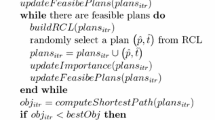Abstract
This paper studies planning interceptor locations in a general transportation network to maximize the benefits of reducing public exposure to violators (e.g., violators in urban transportation networks and terrorists in airline networks). A robust optimization model is proposed to address uncertainties associated with link traffic volumes and the likelihood of having a violator on a particular network route. The potential failure of interceptors and subsequent uncertainties is also considered. The consequent mathematical model has a bi-level program structure and a non-convex inner problem. We propose a number of solution approaches, including the alternating ascent algorithm, convex relaxation, duality techniques and commercial solvers for the inner problem, and greedy randomized adaptive search program (GRASP) algorithms for the outer problem. Several numerical experiments are conducted to illustrate the computational efficiency and solution quality of the proposed algorithms.

Similar content being viewed by others
References
Century Council.: State of drunk driving fatalities in America. http://www.century-council.org/content/state-drunk-driving-fatalities-america-2009-report-released. Accessed 5 July 2011 (2009)
National Highway Traffic Safety Administration (NHTSA).: Fatality analysis reporting system (FARS) web-based encyclopedia. Washington DC: US Department of Transportation Retrieved Apr. 28, 2006 from the World Wide Web: http://www-fars.nhtsa.dot.gov/ (2006)
Firoozi Z., Tang S.H., Ariafar Sh., Ariffin M. K. A. M.: An optimization approach for a joint location inventory model considering quantity discount policy. Arab. J. Sci. Eng. 38, 983–991 (2013)
Hodgson M.J.: A flow-capturing location–allocation model. Geogr. Anal. 22(3), 270–279 (1990)
Berman O., Larson R.C., Fouska N.: Optimal location of discretionary service facilities. Transp. Sci. 26(3), 261–277 (1992)
Berman O., Bertsimas D., Larson R.C.: Locating discretionary service facilities, II: maximizing market size, minimizing inconvenience. Oper. Res. 43(4), 623–632 (1995)
Gzara F., Erkut E.: A Lagrangian relaxation approach to large-scale flow interception problems. Eur. J. Oper. Res. 198, 405–411 (2009)
Boccia M., Sforza A., Strle C: Flow intercepting facility location: problems, models and heuristics. J. Math. Model. Algorithms 8, 35–79 (2009)
Zeng W., Hodgson M.J., Castillo I.: The pickup problem: consumers’ locational preferences in flow interception. Geogr. Anal. 41(1), 107–126 (2009)
Hodgson M.J., Rosing K.E.: A network location–allocation model trading off flow capturing and p-median objectives. Ann. Oper. Res. 40(1–4), 247–260 (1992)
Hodgson M.J., Rosing K.E., Storrier A.L.G.: Applying the flow-capturing location–allocation model to an authentic network: Edmonton, Canada. Eur. J. Oper. Res. 90(3), 427–443 (1996)
Berman O.: Deterministic flow-demand location problems. J. Oper. Res. Soc. 48(1), 75–81 (1997)
Zeng W., Castillo I., Hodgson M.J.: A generalized model for locating facilities on a Network with flow-based demand. Netw. Spat. Econ. 10(4), 579–611 (2008)
Berman O.: The maximizing market size discretionary facility location problem with congestion. Socio-Econ. Plan. Sci. 29(1), 39–46 (1995)
Berman O., Krass D., Xu C.W.: Locating discretionary service facilities based on probabilistic customer flows. Transp. Sci. 29(3), 276–90 (1995)
Berman O., Krass D., Xu C.W.: Locating flow-intercepting facilities: new approaches and results. Ann. Oper. Res. 60(1–4), 121–43 (1995)
Berman O., Krass D., Xu C.W.: Generalized flow-interception facility location models with probabilistic customer flows. Stoch. Model 13(1), 1–25 (1997)
Berman O., Krass D.: Flow intercepting spatial interaction model: a new approach to optimal location of competitive facilities. Locat. Sci. 6(1–4), 41–65 (1998)
Berman O., Krass D.: Locating multiple competitive facilities: spatial interaction model with variable expenditures. Ann. Oper. Res. 111(1–4), 197–225 (2002)
Wu T.H., Lin J.N.: Solving the competitive discretionary service facility location problem. Eur. J. Oper. Res. 144(2), 366–378 (2003)
Hodgson M.J., Berman O.: A billboard location model. Geogr. Environ. Model. 1, 25–45 (1997)
Hodgson M.J., Rosing K.E., Storrier A.L.G.: Applying the flow-capturing location–allocation model to an authentic network: Edmonton, Canada. Eur. J. Oper. Res. 90(3), 427–443 (1996)
Horner M.W., Groves S.: Network flows-based strategies for identifying rail park-and-ride facility locations. Socio-Econ. Plan. Sci. 41(3), 255–268 (2007)
Nourbakhsh S.M., Ouyang Y.: Optimal fueling strategies for locomotive fleets in railroad networks. Transp. Res. Part B 44(8/9), 1104–1114 (2010)
Erdemir E.T., Batta R., Spielman S., Rogerson P.A., Blatt A., Flanigan M.: Location coverage models with demand originating from nodes and paths: application to cellular network design. Eur. Jo. Oper. Res. 190(3), 610–632 (2008)
McMasters A.W., Mustin T.M.: Optimal interdiction of a supply network. Naval Res. Logist. 17, 261–268 (1970)
Steinrauf, R.L.: A network interdiction model. M.S. Thesis, Naval Postgraduate School, Monterey, CA (1991)
Phillips, C.A.: The network destruction problem. SAND-92-0186C, Sandia National Laboratories, Albuquerque, NM (1992)
Wood R.K.: Deterministic network interdiction. Math. Comput. Model. 17(2), 1–18 (1993)
Cormican, K.J.; Morton, D.P.; Wood, R.K.: Stochastic network interdiction. Oper. Res. 46(2), 184–197 (1998)
Train K.E.: Discrete Choice Methods with Simulation. Cambridge University Press, Cambridge (2003)
Carr R.D., Greenberg H.J., Hart W.E., Konjevod G., Lauer E., Lin H., Morrison T., Phillips C.A.: Robust optimization of contaminant sensor placement for community water systems. Math. Program. 107(1), 337–356 (2006)
Zeynep H.G., Christodoulos A.F.: Global optimization of nonlinear bilevel programming problems. J. Glob. Optim. 20(1), 1–31 (2001)
AI-Khayyal F.A., Falk J.E.: Jointly constrained biconvex programming. Math. Oper. Res. 8(2), 273–286 (1983)
Androulakis I.P., Maranas C.D., Floudas C.A.: aBB: a global optimization method for general constrained non-convex problems. J. Glob. Optim. 7(4), 337–363 (1995)
Feo T.A., Resende M.G.C.: Greedy randomized adaptive search procedures. J. Glob. Optim. 6, 109–133 (1995)
Bar-Gera, H.: Transportation network test problems. http://www.bgu.ac.il/~bargera/tntp/. Accessed 17 June 2011 (2001)
Sheffi Y.: Urban Transportation Networks: Equilibrium Analysis with Mathematical Programming Methods. Prentice Hall, England Cliffs, NJ (1985)
Yen J.Y.: Finding the k shortest loopless paths in a network. Manag. Sci. 17(11), 712–716 (1971)
Author information
Authors and Affiliations
Corresponding author
Rights and permissions
About this article
Cite this article
Cui, J., An, S. & Zhao, M. A Robust Model for the Network Violator Interception Problem. Arab J Sci Eng 39, 6871–6881 (2014). https://doi.org/10.1007/s13369-014-1271-8
Received:
Accepted:
Published:
Issue Date:
DOI: https://doi.org/10.1007/s13369-014-1271-8




